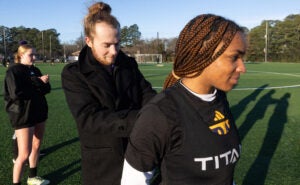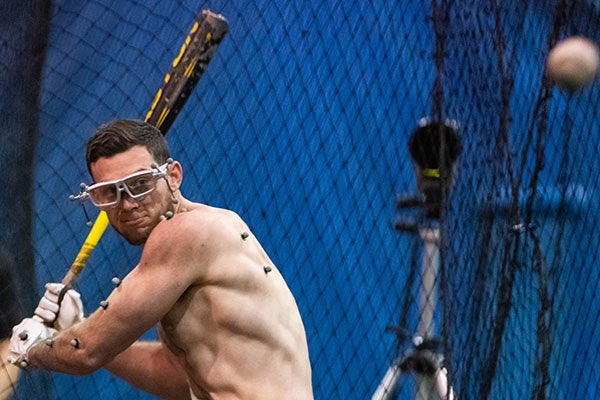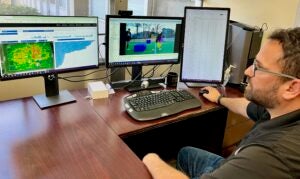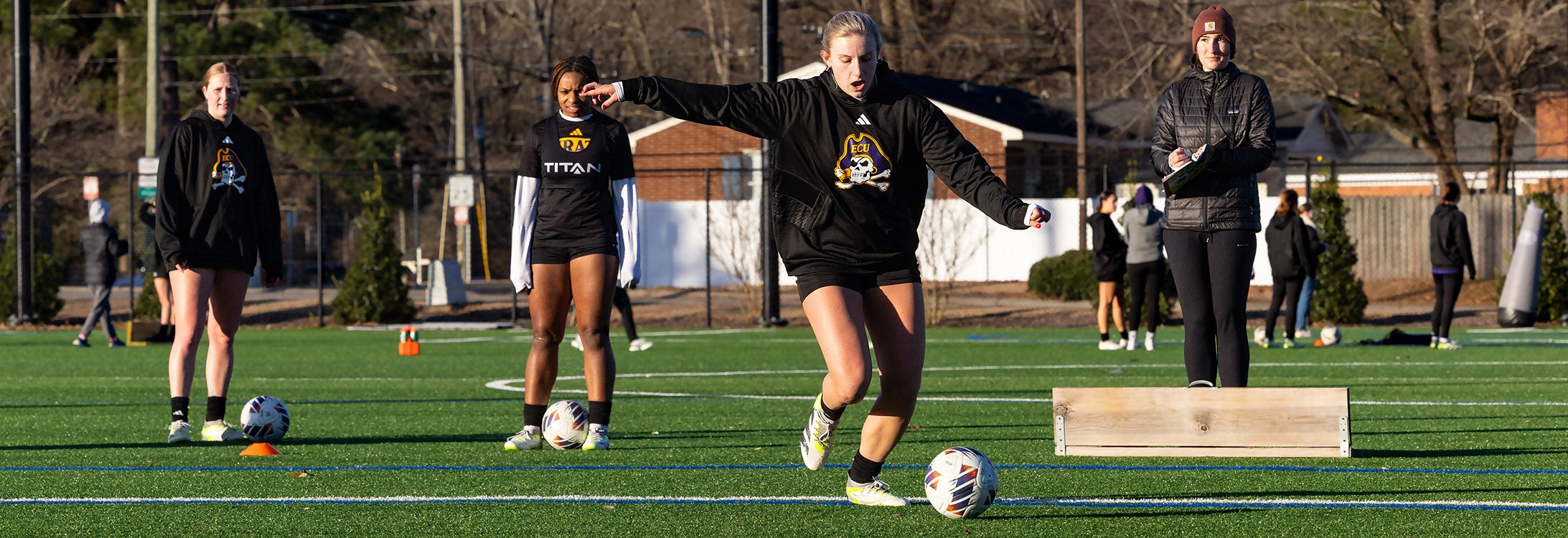PEAK PERFORMANCE
HHP, athletics research collaborations fueling variety of Pirates
Research and sports science have taken Taylor Kinney from studying shoulder biomechanics at a baseball pitching lab in Omaha, Nebraska, and presenting at the 2023 Major League Baseball winter meetings in Nashville, Tennessee, to soccer and track and field workouts on East Carolina University’s athletics campus.
Women’s soccer workouts with the Department of Kinesiology have focused on using different technology tools, like GPS tracking vests and eye-tracking glasses, to help athletes achieve optimal performance. On a recent morning, Kinney, a doctoral student in the biomechanics and motor control concentration, sports psychology expert Dr. Christine Habeeb and other kinesiology representatives led groups of players in a soccer shooting test. Instructor Patrick Rider directed and motivated athletes alongside coaches and strength and conditioning staff as the players pushed mentally and physically through fitness tests amid temperatures in the 30s.

Taylor Kinney adjusts a Titan GPS tracking vest on ECU athlete Amani Green during a recent morning workout
“I think the sky is the limit with what we’ve found here,” Kinney said.
Kinney was referencing the eye-tracking baseball research he and two-time ECU alum and former Pirate baseball pitcher Jake Kuchmaner were selected to present at the American Baseball Biomechanics Society event in conjunction with MLB’s winter meetings, which include droves of team executives, sports scientists and athletic trainers. The kinesiology department in the College of Health and Human Performance has used baseball and golf research findings from the visual motor lab, directed by Dr. Nick Murray, and performance optimization lab, directed by Dr. Zac Domire, in military applications and in partnerships with ECU soccer and ECU track and field.
Soccer players wear the GPS tracking vests during their matches and practices to record a variety of data points, including top speed, velocity, workload and movement trends. Kinesiology personnel analyze data daily to form individual athlete profiles.
“Hopefully we’re on the front edge and looked to as one of the sport leaders with eye-tracking,” said Rider, the department’s director of applied sport science. “In track, we can use GPS sensors to measure velocity, and the big piece is high-speed video and the constant biofeedback athletes get from those things. Right now, GPS technology is probably the primary piece of technology we’re using with the soccer team. Eye-tracking will be used if we have a specific question and need to use it. … I try to find different technology we can use and what kind of data do we get from it, and then how can that be helpful to the athletes, coaches and scientists. My approach has always been to bring in as many stakeholders on board and coordinate it so that everybody wins.”
In the results
Data and high-speed video have helped Royal Burris with his footwork for the start of sprint races.
Last year, he ran the 200-meter dash in 20.20 seconds to break an ECU record that had stood since 1988. Record-breaking marks lately have been led by Burris and women’s sprinter Melicia Mouzzon, who ran the 60-meter dash in a school-record 7.27 seconds for an American Athletic Conference indoor championship performance a few weeks ago.
“There are some athletes who are running faster than they’ve ever run at ECU, and coach Udon Cheek was recognized for this at a national track and field conference and mentioned that our partnership has been useful in helping them achieve their goals,” Rider said.
Maeve English is the Pirate soccer team’s starting goalie who has collected multiple all-conference selections on the field in addition to 2023 academic all-district honors. She said reaction time and subconscious decisions affect a goalie’s performance during a game, but thanks to ECU, she also has benefitted from using eye-tracking glasses and other research tools.
“To have a base metric to actually track improvement is really helpful for our team,” English said. “With vision, there are different times in the game when you are watching different parts, so to be able to see maybe how often I’m scanning the field or how often I’m focusing on something — whether it’s a player or the ball — is super interesting. … For me personally, I was not scanning as often as I thought I was. I think it’s just helpful to see that.”
English, a Greenville native who graduated from D.H. Conley High School, is an engineering major.
“I love numbers and love being able to quantify things,” she said. “It’s definitely very interesting and I worked last semester with Patrick on a research project, so I got to see more of the behind-the-scenes. That has been really cool.”

A baseball player swings at Next Level Training Center for a previous study in the College of Health and Human Performance using motion-capture and eye-tracking technology. (ECU News Services Cliff Hollis photo)
Kuchmaner was “perfect” in an ECU baseball game March 17, 2019, at Maryland. He retired all 27 Maryland batters in order to pitch the only perfect game in ECU baseball’s rich history.
Like many athletes, he wasn’t thinking much about eye movement or biomechanics during that perfect pitching performance. Years later, after presenting his thesis research about steady eyes during pitching and his work as a pitching instructor at Next Level Training Center, he can relay kinesiology insight to others with ease.
“As a player, you are always trying to find whatever methods work and what doesn’t work,” Kuchmaner said. “I was humbled very fast at how hard it is to find significant training methods, so I definitely have grown an appreciation for sports science. It can really change a player’s path or a team’s path, if used correctly.”
Added Kinney: “It’s been done in basketball and table tennis and a lot of sports, but nobody has really approached standardized eye-tracking in (baseball) pitching. It is kind of intuitive that you really need to look at something to throw a baseball to an exact spot, but nobody has really formalized that. We want to be the first ones to show numbers to back this up.”
A coach’s view
One of the first connections women’s soccer head coach Gary Higgins pursued when he arrived at ECU in 2022 was with the College of Health and Human Performance. It worked well for him at Lenoir-Rhyne University, where he totaled 83 wins in seven seasons to become the all-time winningest coach in program history, and there was potential at ECU to continue and even enhance success.
A connection was made to Rider and partnership formed, which Higgins values as a resource at ECU.
“We are looking for marginal gains, individually and collectively, so there’s a number of things from finishing to passing tests to cardiovascular and endurance that are valuable,” Higgins said. “Managing and measuring those things are all vital to improving our performance on the field.
“I don’t know how many schools have such a collaborative relationship with their department. Some of them may use it and some of them might use data analysis, but I really value our relationships with our professors and our kinesiology department here. It’s pretty special, in my opinion.”
That is evident during conversations with Rider and others about performance-based research.
“We provide data to the coaches to help them make the most informed decisions they can related to their teams and athletes,” Rider said. “In addition, we help interpret data we collect and serve as a sounding board for the coaches and athletes to ask sport science related questions. Many times, through these conversations, we will get ideas for new research questions that we can answer with the data we’ve collected. I never want the athletes to feel like they are guinea pigs, even though we are collecting a lot of information. All of our data collections are designed to flow with what the team would normally be doing without our involvement.”
What’s next?

Patrick Rider, the Department of Kinesiology’s director of applied sport science, looks at data on computer screens in his office. (Photo by Ronnie Woodward)
Collaboration is vital to success with HHP’s kinesiology and other labs. Collaboration, using the visual motor lab and multiple baseball studies as an example, also has led to versatility in furthering research.
“The breadth of stuff you can do with this is really quite impressive,” Domire said. “We have a lot of applications outside the sports realm as well, from military applications to health applications and police applications. The applications are really broad.”
Student involvement in these research projects also provides long-term benefits.
“One of the major benefits of these partnerships with soccer and track is having our students able to gain practical experience using cutting-edge technology,” Rider said. “These students will be applying for jobs that require them to use these types of technological skills. For example, there are many job descriptions in the sport science domain looking for familiarity with GPS tracking. Students can gain high-quality, marketable experience through opportunities like this.”
